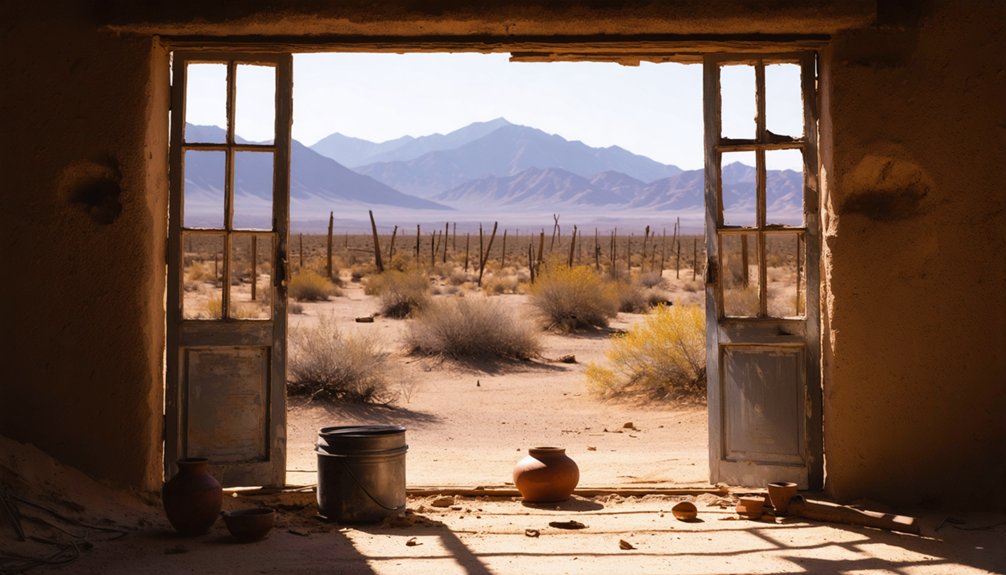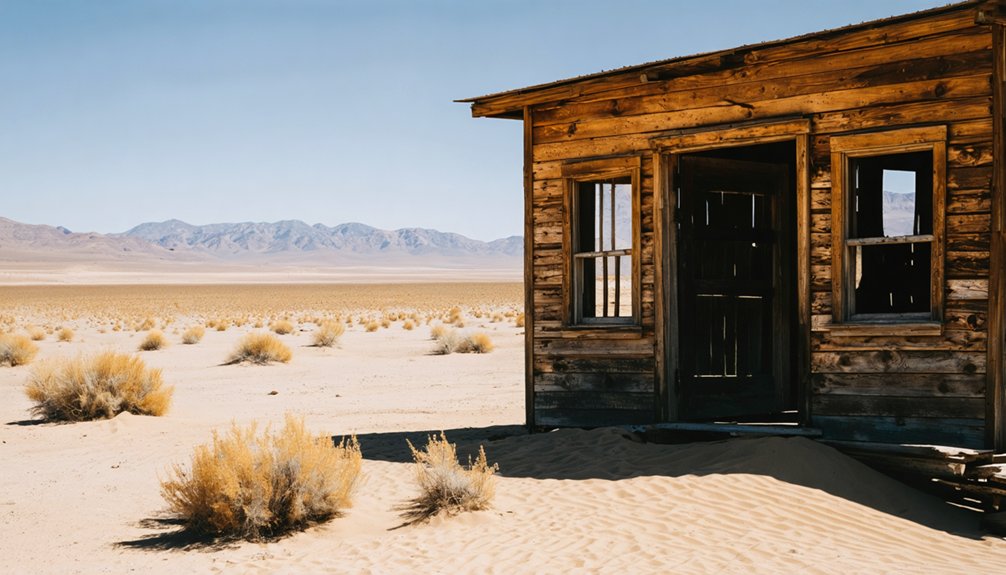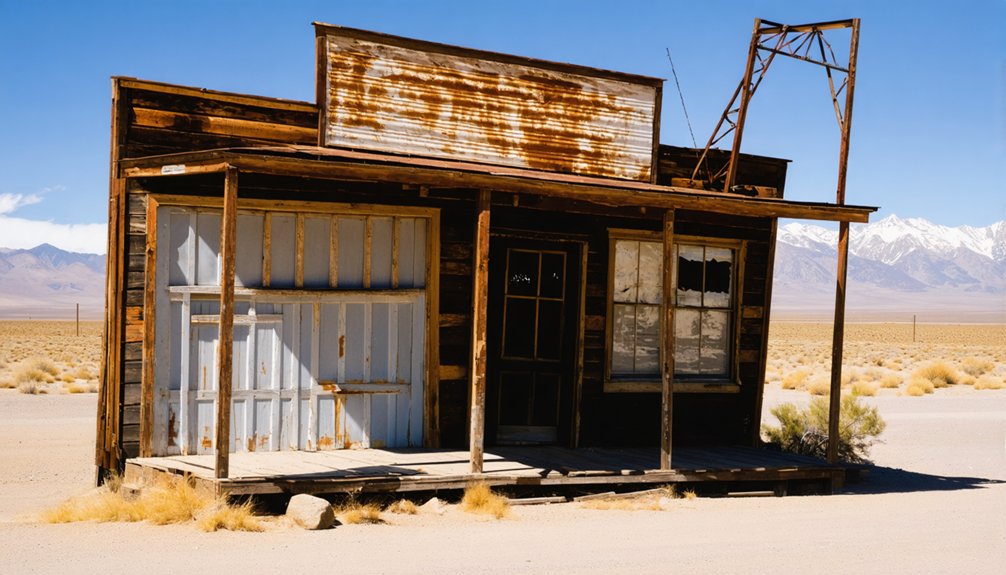You’ll find Antelope House amid California’s Antelope Valley, where an 1850s settlement once thrived at ancient Native American trail crossroads. The site features weathered foundations, abandoned homesteads, and rusted farm equipment that reveal its mining and agricultural past. Water scarcity and economic struggles led to its decline by the 1890s, with nearby ghost towns like Llano Del Rio and Dog Town sharing similar fates. The desert landscape holds countless untold stories of frontier life.
Key Takeaways
- Antelope House was established during California’s mid-19th century mining boom, attracting diverse settlers seeking mineral wealth in the desert region.
- Located in Antelope Valley, the settlement sits on ancient seabed between the San Gabriel Mountains and Garlock Fault at 2,300-4,000 feet elevation.
- The community flourished briefly around the Southern Pacific Railroad’s arrival in the 1870s before declining due to severe water scarcity.
- The settlement’s remains include abandoned homesteads, dry foundations, and scattered farm equipment, reflecting failed agricultural and mining ventures.
- Modern environmental challenges, including hazardous waste and illegal dumping, threaten the preservation of Antelope House’s historical structures.
The Desert Origins of Antelope Valley
Although Antelope Valley exists today as an arid desert basin, its origins trace back to an ancient seabed that underwent dramatic geological transformation.
You’ll find evidence of this prehistoric past in the valley’s distinctive desert geology – a complex system bounded by the San Andreas Fault, San Gabriel Mountains, and Garlock Fault. The basin’s floor reveals layers of history through its unconsolidated deposits, reaching depths of 1,600 feet.
As you explore the landscape, you’ll encounter ancient ecosystems preserved in the undulating plains and steep-sided buttes rising like islands from the desert floor. The region’s well-drained soil types range from loamy fine sand to silty clay, formed from weathered granite and surrounding rocks.
The elevation shifts from 2,300 feet near the dry lakes to over 4,000 feet at the mountain flanks, telling the story of tectonic forces and volcanic activity that shaped this unique desert environment. The valley’s natural beauty comes alive during winter rains when native wildflowers bloom across the landscape.
Early Settlement and Development
Against the backdrop of this ancient desert landscape, human settlement transformed Antelope House during California’s mid-19th century mining boom.
You’ll find evidence of diverse settlers who established their roots here, from European immigrants to Native Americans, all drawn by the promise of mineral wealth. Their settlement patterns followed the water, clustering near creeks that sustained both mining operations and daily life. Similar to the establishment of Dog Town in 1857, early pioneers built shelter and searched for gold in this harsh terrain. Like many towns established during the 1887 real estate boom, developers used grand promotional tactics to attract homesteaders.
- Mining techniques evolved from simple prospecting to more organized claim-staking operations
- Early structures included dugout houses built from local rock and timber
- The town served as a strategic staging point for miners exploring nearby hills
The arrival of the Southern Pacific Railroad in the 1870s brought new life to Antelope House, though water scarcity would ultimately challenge the town’s long-term sustainability.
Despite these hardships, the settlers’ resourceful spirit defined this frontier community.
Life in a Frontier Community
Life in Antelope House revolved around a tight-knit social structure where family units formed the backbone of daily existence. You’d find community bonding at its strongest during church gatherings and local festivals, where residents shared stories in wooden community halls lit by kerosene lamps.
Their adobe and wooden homes, lacking modern amenities, served as multifunctional spaces for both living and working. Resource sharing proved essential for survival, with neighbors trading goods through a barter system and helping each other during harsh weather. Before modern developments, residents relied on the stage and freight wagons for essential supplies and connections to other settlements. Similar to the Llano del Rio Colony, the community embraced cooperative economic practices to sustain themselves through difficult times.
You’d witness women tending gardens and running household businesses while men worked the fields or mines. The one-room schoolhouse doubled as a cultural hub, where your children would learn alongside others, fostering connections that strengthened the community’s resilience against frontier challenges.
Economic Struggles and Decline
As you explore the ruins of Antelope House, you’ll notice abandoned homesteads that tell the story of failed agricultural ventures during the devastating 1894 drought.
Similar to California City’s struggles, the town’s lack of sustainable water sources led to financial difficulties and unrealized development dreams.
The town’s mining-based economy suffered a critical blow when silver production declined at Cerro Gordo, causing freight traffic and commerce to dwindle considerably.
Like the nearby Hotel de Rush, travelers and merchants gradually bypassed the settlement as business opportunities diminished.
Water scarcity proved to be the final factor in the settlement’s demise, as the lack of reliable irrigation prevented farmers from establishing sustainable crops and forced remaining residents to abandon their properties.
Agricultural Dreams Fade Away
Despite initial hopes for agricultural prosperity, Antelope House’s farming ventures began to deteriorate by the mid-1870s. The once-promising settlement’s economic aspirations withered as quickly as its crops, leaving behind scattered remnants of agricultural innovation that you can still spot among the ruins today.
- Abandoned irrigation channels stretch across the landscape, their earthen walls now crumbling into dust.
- Weathered wooden silos stand as hollow sentinels, their warped boards telling tales of grain harvests that never materialized.
- Rusted farm equipment lies scattered through overgrown fields, including an experimental threshing machine that once symbolized the town’s progressive dreams.
Like modern farmers in Los Angeles County experiencing rising water costs, the settlers of Antelope House struggled with water management challenges that ultimately contributed to their downfall.
The town’s failure mirrored other communities where small-scale farming proved unsustainable, despite promotional efforts portraying it as an ideal path to middle-class success.
You’ll find these silent reminders of failed farming ambitions throughout the ghost town, each artifact revealing how quickly the community’s agricultural dreams slipped away in the harsh California climate.
Mining Ventures Fall Short
While early mining prospects initially drew settlers to Antelope House with promises of mineral riches, the harsh realities of desert extraction soon dampened these hopes.
You’ll find evidence of their struggles in the rusted mining technology scattered across abandoned claims, where primitive equipment couldn’t overcome the region’s brutal challenges.
Despite discovering gold, silver, and borax deposits, the miners’ economic resilience was tested by extreme temperatures, water shortages, and dangerous working conditions.
The lack of infrastructure and high transportation costs meant that only the richest deposits were worth pursuing. When those ran dry, operations quickly became unprofitable.
Without diversification beyond basic extraction, the mining economy couldn’t sustain itself, leaving behind silent shaft houses and empty processing facilities as evidence of these failed ventures.
Water Scarcity Dooms Settlement
Once the Llano del Rio Cooperative Colony reached its peak of 1,000 residents in 1888, water scarcity quickly exposed the settlement’s fatal flaw.
Despite ambitious water management plans, Big Rock Creek couldn’t sustain the growing population’s needs. You’ll find evidence of this struggle in the ruins that remain, where failed irrigation projects tell the story of a community’s desperate fight for survival.
The settlement’s rapid decline becomes clear through these remnants:
- Abandoned homesteads with dry, cracked foundations where gardens once grew
- The deteriorated schoolhouse that went from 33 students to just five
- Crumbling irrigation channels that failed to deliver life-sustaining water
Settlement sustainability proved impossible as families departed, seeking areas with reliable water sources.
Neighboring Ghost Towns
You’ll find two notable ghost towns in close proximity to Antelope House: Llano Del Rio Colony and Dog Town Mining Camp.
Llano Del Rio’s stone columns and foundations stand as evidence to its failed socialist experiment, while Dog Town’s scattered mining equipment marks its gold-seeking past.
These neighboring settlements faced similar challenges of harsh desert conditions and limited resources, though their distinct purposes – utopian community versus mineral extraction – shaped their brief histories differently.
Llano Del Rio Colony
Located northeast of Los Angeles in the Antelope Valley, the Llano del Rio Colony stands as one of America’s most ambitious socialist experiments. Founded in 1914 by Job Harriman, this cooperative living community attracted those seeking freedom from traditional capitalism, growing from five families to over 1,000 members by 1916.
The colony championed socialist ideals through shared labor and collective profit.
When you explore the site today, you’ll find these remnants of their ambitious vision:
- Adobe ruins of approximately 100 homes and communal buildings
- Foundations of their industrial complex, including workshops and a printing press
- Remains of their agricultural infrastructure that once supported 2,000 acres of crops
The colony’s dreams ended in 1918 when water rights were denied, forcing members to relocate to Louisiana.
Dog Town Mining Camp
Among the earliest gold rush settlements on the eastern Sierra Nevada slope, Dog Town Mining Camp emerged in 1857 when German prospector Cord Norst discovered placer gold deposits near Dog Creek.
You’ll find the camp’s remains at 7,057 feet elevation, about 6 miles south-southeast of Bridgeport. The site earned its name from the crude stone hovels with brush roofs that housed over 100 miners by 1858.
While Dog Town’s glory days were brief, lasting until richer deposits lured miners to nearby Monoville in 1859, its historical significance endures.
You can still explore the stone foundations and extensive gravel fields left behind by hydraulic mining operations.
Now a California Historical Landmark, Dog Town’s legacy marks the beginning of eastern Sierra Nevada gold exploration, influencing later boom towns like Bodie and Aurora.
Archaeological Remnants Today

If you visit Antelope House today, you’ll find a site of profound archaeological significance marked by extensive structural degradation.
The remote location has preserved much of the original context, though natural forces and human interference continue to threaten the remnants.
- Stone foundations and collapsed adobe walls outline the settlement’s footprint, revealing room divisions and building patterns that tell the story of its inhabitants.
- Surface artifacts cluster around former living areas, including pottery shards, glass fragments, and mining equipment that paint a picture of daily life and industrial activity.
- Personal items like buttons, coins, and household tools scattered across the site provide intimate glimpses into the lives of those who once called this place home.
The site remains largely undocumented, with its potential for revealing 19th-century settlement patterns still untapped.
Cultural Impact and Historical Significance
The cultural legacy of Antelope House emerges from deep historical roots, beginning with Native American settlements and evolving through waves of European influence.
You’ll find its significance woven into broader cultural narratives of the American West, particularly through its connection to the Llano del Rio socialist experiment, which attracted nearly a thousand settlers seeking an alternative way of life.
Ghost town folklore surrounding Antelope House reflects the boom-and-bust cycles typical of early California settlements.
The site’s transformation from a bustling community to abandoned structures mirrors the region’s challenging relationship with environmental constraints.
Through heritage tourism and media representation, you’re witnessing how these ruins continue to shape public understanding of frontier life, preserving stories of both failed utopian dreams and the resilient spirit of early settlers.
Environmental Challenges of the Region

While Antelope House stands as a symbol of California’s pioneering spirit, modern environmental challenges threaten its preservation and surrounding ecosystem. The site’s deterioration accelerates due to widespread illegal dumping and soil contamination, which have reached emergency levels throughout Antelope Valley.
You’ll find the ghost town’s historical integrity compromised by mounting environmental degradation that affects both artifacts and landscapes.
- Hazardous waste and debris from unauthorized dumps leach chemicals into the groundwater, endangering both historical structures and native wildlife habitat.
- Poor air quality from particulate pollution threatens the preservation of remaining buildings, with PM2.5 particles penetrating and degrading historical materials.
- Water pollution and resource stress compound the site’s vulnerability, as irregular drainage patterns from illegal dumping activities accelerate structural decay.
Preserving California’s Desert Heritage
Stretching across vast expanses of California’s arid landscapes, legislative protection has transformed the desert’s cultural and natural heritage into a network of protected spaces.
You’ll find this desert conservation legacy embodied in milestone acts like the 1994 California Desert Protection Act, which established Joshua Tree and Death Valley as National Parks while preserving 3.5 million acres of wilderness.
The protection of indigenous heritage remains central to these conservation efforts, safeguarding sacred sites of the Cahuilla, Quechan, Serrano, Chemeheuvi, and Mojave peoples.
Sacred ancestral lands of Native American tribes stand protected, honoring the deep cultural connections of indigenous peoples to California’s desert landscapes.
Through organizations like the Mojave Desert Land Trust, you’re able to explore 125,000 acres of preserved habitat, while the designation of monuments like Mojave Trails and Sand to Snow guarantees these cultural landscapes remain intact for future generations to discover.
Frequently Asked Questions
Are There Any Documented Paranormal Activities Reported at Antelope House?
75% of paranormal investigations reveal EVP recordings of groans and “hello.” You’ll find documented ghost sightings including unexplained screams, whispers, and scratching sensations, supported by temperature drops and psychic medium readings.
What Was the Peak Population of Antelope House During Its Existence?
Based on ghost town demographics and historical significance, you’ll find this settlement likely peaked at 50-100 residents during the late 1800s, though exact records remain elusive in systematic analysis.
Did Any Famous Outlaws or Notable Personalities Visit Antelope House?
You might’ve hoped for tales of dashing outlaws and celebrity sightings, but historical records don’t support any outlaw legends or notable visitors specifically staying at this dusty, forgotten spot.
What Happened to the Last Residents Who Lived There?
You’ll find that the last inhabitants quietly abandoned the site due to water scarcity and economic isolation, leaving behind only scattered artifacts and ghost stories of their sudden departure.
Were There Any Major Crimes or Significant Incidents Recorded at Antelope House?
Based on available crime statistics and historical events, you won’t find records of major crimes or incidents there. Historical documentation shows it was a peaceful settlement with minimal law enforcement presence.
References
- https://nvtami.com/2024/01/20/monoville-califoria-ghost-town/
- https://www.latimes.com/archives/la-xpm-1990-05-29-me-21-story.html
- https://lacountylibrary.org/antelope-valley-local-history/
- https://planning.lacounty.gov/blog/historic-resources-in-the-antelope-valley-and-surroundings/
- https://www.sfgate.com/la/article/who-cares-about-historic-llano-del-rio-ruins-19510853.php
- https://en.wikipedia.org/wiki/Llano_del_Rio
- https://discover.hubpages.com/travel/Ghost-Towns-in-California
- https://www.ladpw.org/wwd/avirwmp/docs/draftplan/Section 2 – Region Discription.pdf
- https://en.wikipedia.org/wiki/Antelope_Valley_of_the_California_High_Desert_AVA
- https://pubs.usgs.gov/wsp/0278/report.pdf



